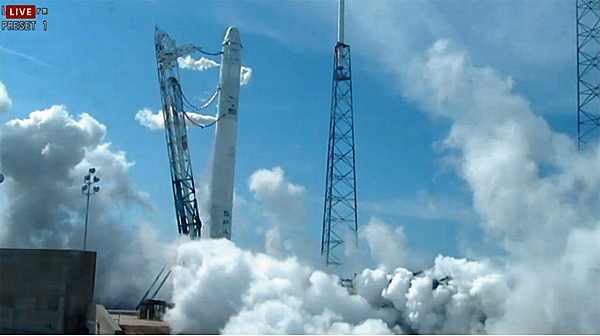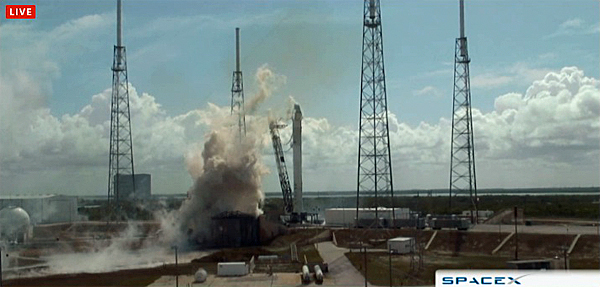SpaceX test fires Falcon 9 engines in prelude to May 7 station flight
By WILLIAM HARWOOD
CBS News
KENNEDY SPACE CENTER, FL--Working by remote control, Space Exploration Technologies engineers briefly test fired the nine first stage engines powering the company's Falcon 9 rocket Monday, a key milestone before launch May 7 on the first commercial cargo flight to the International Space Station.
The two-second test firing at launch complex 40 at the Cape Canaveral Air Force Station produced a jet of flame and a billowing cloud of exhaust as all nine SpaceX-designed Merlin engines were commanded to fire at 4:15 p.m. EDT (GMT-4). The engines generate up to 125,000 pounds of thrust each, or 1.1 million pounds of push working in concert.
In a Twitter posting, SpaceX declared the test a success and added "engineers will now review data as we continue to prepare for the upcoming mission."
"Woohoo, rocket hold down firing completed and all looks good!" SpaceX founder and chief designer Elon Musk tweeted.
The test firing was delayed an hour and 15 minutes after a glitch at the T-minus 47-second mark triggered a countdown abort. But engineers resolved the problem and the second time around, there were no obvious signs of trouble.
"During the rehearsal, SpaceX engineers will run through all countdown processes as though it were launch day," the company said in an earlier statement. "The exercise will end with all nine engines firing at full power for two seconds. After the test, SpaceX will conduct a thorough review of all data as engineers make final preparations for the upcoming launch."
If a detailed review of engineering data confirms that, SpaceX engineers plan to launch the company's first operational Dragon cargo ship atop the Falcon 9 at 9:38 a.m. next Monday, roughly the moment Earth's rotation carries the launch pad into the plane of the space station's orbit.
If the weather or technical problems force a delay, SpaceX can make another attempt May 10. After that, SpaceX would be forced to stand down to clear the decks for launch of a Russian Soyuz spacecraft carrying three fresh crew members to the space station. That mission is scheduled for launch from the Baikonur Cosmodrome in Kazakhstan on May 14 U.S. time, with docking expected two days later.
Whenever it flies, the SpaceX flight plan calls for the Dragon capsule to first fly a close approach to the space station on flight day three to test the spacecraft's navigation and abort systems. The next day, the spacecraft will carry out a stepwise approach to within about 30 feet of the lab complex. At that point, the Dragon cargo ship will be grappled by the station's robot arm, operated by NASA flight engineer Donald Pettit and European Space Agency astronaut Andre Kuipers, and moved in for berthing at the Earth-facing port of the forward Harmony module.
Hatches will be opened the next day. For its initial visit, the Dragon capsule will be carrying 1,150 pounds of non-critical equipment and supplies, including clothing and food for upcoming crews. If all goes well, Dragon will remained docked for about three weeks. Loaded with 1,455 pounds of hardware and other equipment needed back on Earth, the cargo craft then will execute a re-entry and splashdown off the coast of California.
CBS News
KENNEDY SPACE CENTER, FL--Working by remote control, Space Exploration Technologies engineers briefly test fired the nine first stage engines powering the company's Falcon 9 rocket Monday, a key milestone before launch May 7 on the first commercial cargo flight to the International Space Station.
 |
| The nine first stage engines in a SpaceX Falcon 9 rocket were cranked up in a two-second test firing Monday to clear the way for launch next week on a commercial space station resupply mission. (Credit: SpaceX webcast) |
The two-second test firing at launch complex 40 at the Cape Canaveral Air Force Station produced a jet of flame and a billowing cloud of exhaust as all nine SpaceX-designed Merlin engines were commanded to fire at 4:15 p.m. EDT (GMT-4). The engines generate up to 125,000 pounds of thrust each, or 1.1 million pounds of push working in concert.
In a Twitter posting, SpaceX declared the test a success and added "engineers will now review data as we continue to prepare for the upcoming mission."
"Woohoo, rocket hold down firing completed and all looks good!" SpaceX founder and chief designer Elon Musk tweeted.
The test firing was delayed an hour and 15 minutes after a glitch at the T-minus 47-second mark triggered a countdown abort. But engineers resolved the problem and the second time around, there were no obvious signs of trouble.
"During the rehearsal, SpaceX engineers will run through all countdown processes as though it were launch day," the company said in an earlier statement. "The exercise will end with all nine engines firing at full power for two seconds. After the test, SpaceX will conduct a thorough review of all data as engineers make final preparations for the upcoming launch."
 |
| (Credit: SpaceX webcast) |
If a detailed review of engineering data confirms that, SpaceX engineers plan to launch the company's first operational Dragon cargo ship atop the Falcon 9 at 9:38 a.m. next Monday, roughly the moment Earth's rotation carries the launch pad into the plane of the space station's orbit.
If the weather or technical problems force a delay, SpaceX can make another attempt May 10. After that, SpaceX would be forced to stand down to clear the decks for launch of a Russian Soyuz spacecraft carrying three fresh crew members to the space station. That mission is scheduled for launch from the Baikonur Cosmodrome in Kazakhstan on May 14 U.S. time, with docking expected two days later.
Whenever it flies, the SpaceX flight plan calls for the Dragon capsule to first fly a close approach to the space station on flight day three to test the spacecraft's navigation and abort systems. The next day, the spacecraft will carry out a stepwise approach to within about 30 feet of the lab complex. At that point, the Dragon cargo ship will be grappled by the station's robot arm, operated by NASA flight engineer Donald Pettit and European Space Agency astronaut Andre Kuipers, and moved in for berthing at the Earth-facing port of the forward Harmony module.
Hatches will be opened the next day. For its initial visit, the Dragon capsule will be carrying 1,150 pounds of non-critical equipment and supplies, including clothing and food for upcoming crews. If all goes well, Dragon will remained docked for about three weeks. Loaded with 1,455 pounds of hardware and other equipment needed back on Earth, the cargo craft then will execute a re-entry and splashdown off the coast of California.